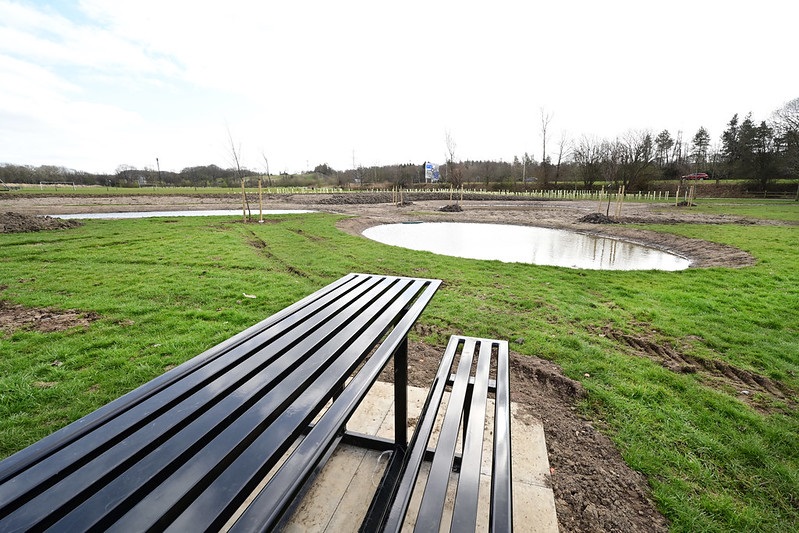Rannoch Park gets a climate-ready makeover

Rannoch Park in Grangemouth has had a green upgrade as part of efforts to tackle climate change and make urban greenspaces more welcoming.
A programme of improvements got underway at the end of last year to make Rannoch Park better equipped to deal with extreme weather, improve biodiversity, and create a more enjoyable space for everyone who uses it.
The climate resilient project costing over £110,000 has been funded by Falkirk Council, The National Lottery Heritage Fund, via Climate FORTH, and the Green Action Trust.
One of the key aims is to manage heavy rainfall more sustainably. New shallow basins and drainage channels have been introduced to capture and store surface water, helping to reduce the risk of flooding. Around these features, new planting - including trees, natural grasses, and wildflowers - will help soak up water, reduce runoff, and support local wildlife.
By reshaping the landscape and planting woodland and meadow areas, the park will offer new habitats for birds, insects, and pollinators. Trees will also provide shade and shelter, cut down noise, and help clean the air. These changes will support biodiversity while making the park a more comfortable place to spend time.
Councillor Paul Garner, Falkirk Council’s Depute Leader said:
Rannoch Park is a valued green space at the heart of the Grangemouth community, and it’s great to see it being enhanced in ways that will make a real difference both now and for future generations.
“These improvements not only help us adapt to the challenges of climate change but also make the park a more welcoming and enjoyable place for local people.

The project also includes upgrades that make the park more inviting and easier to enjoy. Two new paths will improve access, a picnic area with benches has been added, and the eastern football pitch has been reoriented for better use of space. Spring bulbs will brighten up the park and mark seasonal change.
James Stead, Project manager for Climate FORTH said:
It’s fantastic to see how Rannoch Park has been re-shaped for the future benefit of the local community and local wildlife – while ensuring the green space’s features are adapted to a changing climate. The actions taken at Rannoch Park can be an example for other parks to follow in the future and demonstrate ways to increase climate resilience within our natural heritage sites.
The project team worked closely with local residents to shape the plans. Through online surveys, conversations with park users, posters, and a community event in the park, more than 40 local people shared their thoughts.
Feedback directly influenced the design ensuring changes reflect what the community wants and needs from their local greenspace.
Councillor Bryan Deakin, portfolio holder for Climate Change at Falkirk Council added:
This project at Rannoch Park shows what climate resilience looks like on the ground - practical changes that make our communities better prepared for the future.
“By managing rainfall more sustainably, creating habitats for wildlife, and reshaping how we use green spaces, we’re taking vital steps to adapt to a changing climate while improving everyday quality of life.
During the research phase of the project, a Historic Environment Scotland record of an Iron Age homestead hidden beneath the grass. Known as a Bowhouse, this ancient settlement likely dates back to between 700 BC and 500 AD.
The community was unaware of this heritage, yet it provides context to the area with Bowhouse featuring in the names of businesses and community groups locally.
Its location near the Grange Burn suggests early residents relied on the waterway for life and livestock. Today, the underground ditches and circular features still trace the shape of the long-lost home.
Izzie Curnock, Green Action Trust’s Development Officer said:
It’s been a wonderful project to be involved in. The community has been very supportive from the outset, welcoming investment into the park. It’s been great seeing people already start to use the new paths, and we look forward to watching the planting mature and seeing what new wildlife makes the park its home.
Rannoch Park is one of two pilot sites funded by Climate FORTH - along with Glendevon Drive in Raploch, Stirling - testing new ways to manage urban greenspace in the face of climate change.
Both projects are exploring how to balance environmental needs with the day-to-day value these spaces offer local communities.
Innovative monitoring techniques, alongside traditional wildlife and maintenance surveys, will track the impact of the changes - helping to inform future green projects across the region.